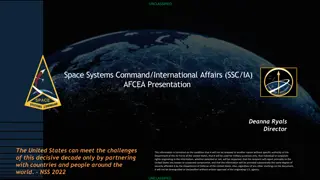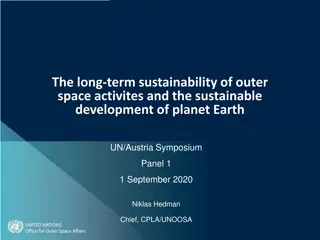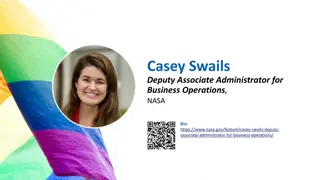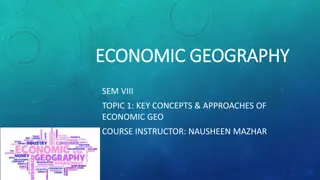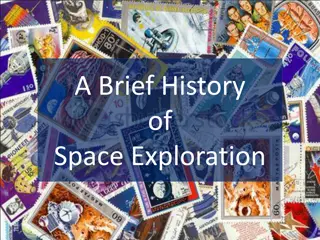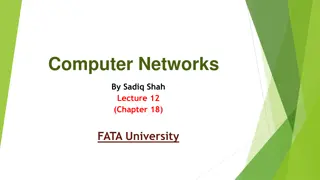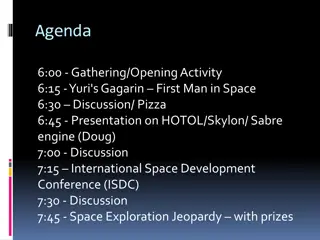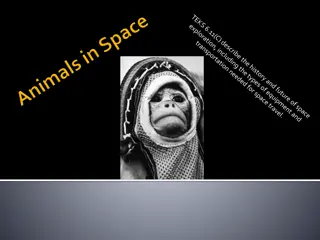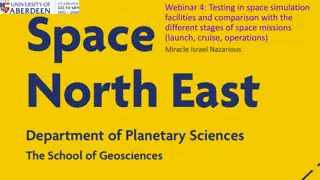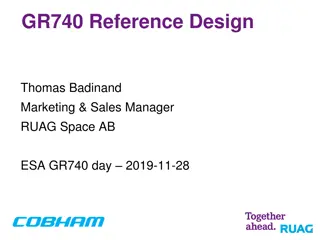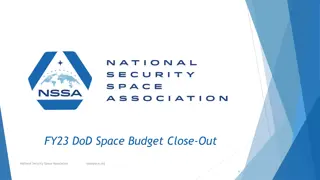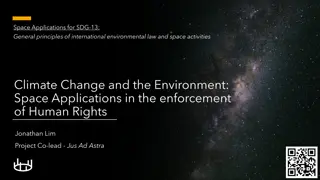Economic Benefits of Space Technology in Addressing Global Challenges
Space technology plays a crucial role in tackling various global challenges such as climate change, natural disasters, healthcare, education, and more. It enables remote education, healthcare services, emergency warning systems, disaster response, pollution detection, and national defense. The economic impacts of leveraging space technology to address these challenges are significant and essential for building resilience and preparedness in the face of emerging threats like climate change and cosmic hazards.
Download Presentation

Please find below an Image/Link to download the presentation.
The content on the website is provided AS IS for your information and personal use only. It may not be sold, licensed, or shared on other websites without obtaining consent from the author.If you encounter any issues during the download, it is possible that the publisher has removed the file from their server.
You are allowed to download the files provided on this website for personal or commercial use, subject to the condition that they are used lawfully. All files are the property of their respective owners.
The content on the website is provided AS IS for your information and personal use only. It may not be sold, licensed, or shared on other websites without obtaining consent from the author.
E N D
Presentation Transcript
McGill University-World Economic Forum Session on the Economic Benefits of Space Joseph N. Pelton Former Dean, International Space Univ. and former Director of Intelsat s Project SHARE July 2013
Space technology is now essential to coping with climate change, problems such as the Ozone Hole and other atmospheric and stratospheric issues. Recently there are signs of cracks in the Earth s magnetic field and changes to the Van Allen s belts that suggest serious concerns from cosmic hazards may increase in coming years. Again the economic impact and risk levels are outside the scope of easy imagination but understand that this ricks are potentially far, far greater than the damage caused by weapons of mass destruction.
Tele-education and tele-health services are just the start Emergency warning systems (hurricanes, tsunamis, volcanoes, tornados, earthquakes, etc.) and emergency recovery National and regional coordination of governmental programs Health alerts and pandemic warnings National criminal data bases & police communications (terrorist attack responses, amber alerts, etc.) Air traffic control and management, especially during take off and landing. Air, land and water pollution alerts (oil spills, toxic waste) Global ability to respond to climate change & severe weather events/natural disasters.
Remote/Rural Education and Healthcare. Effective land use by Farmers, Foresters, Miners, etc. Fire detection and mitigation. Location of fish or wildlife Detection of oil, gas, or mineral reserves Air and water pollution detection and mitigation National Defense Map Making and Updating Weather forecasting Flood control (planning, forecasting, mitigation) Industrial training Development of new industries Effective broadband digital national telecommunications, IT and video networks for news, sports, entertainment, education and health services.
There are about 1,400 communicable diseases and half of the world's population lives in endemic areas. Despite the advances of modern medicine, diseases like malaria, dengue fever and even the plague still afflict millions of people each year. Malaria alone infects up to 500 million persons each year, killing at least a million. Global climate change and variations with the seasons have a significant effect on environment- dependent diseases. In recent years earth observation technology has been used to improve risk mapping for communicable diseases such as malaria, blue tongue, water-borne cholera and of course malaria. Much more needs to be done to get this information to health care workers and doctors.
Australia satellite based health services are integrated with bush-pilot doctors Canada has perhaps the most experience with rural based tele-education and tele-health services than any country. Satellite networks for the Caribbean and South Pacific have been providing tele-health and tele- education for decades. (University of the South Pacific) and the Caribbean Knowledge and Learning Network) (Satmex) Evolution of the Indosat network. (Indonesia satellite one of the first networks first designed for remote oil & mining, then extended to tele-education and now for tele-health services.
The vibrations that were set in motion with the flight of Sputnik in October 1957 have shaken up global civilization. The shifts, triggered by new space-related enterprise, now provide improvement to our lives, more effective education and research system and better health care, improved methods to cope with climate change, and even strengthened patterns of global cooperation. The result has been thousands of new industrial products and tens of thousands new services. Earlier studies concluded that every dollar invested in space research producing $7 in new economic activity. (See Mid West Research Report), Most fundamentally space applications and research plays a critical role in human survival by its contributions to the understanding of climate change and the key role the ozone layer plays in saving humans from genetic destruction due to radiation from outer space. Dr. Lance Bush, Pres. & CEO, The Challenger Center. Today almost 1/3 of India s ATM are broadband Satellite based. The African Development Bank connections to the cloud at 32 and soon 36 locations are satellite based. New O3b satellite will change the equation even more in equatorial regions. Note: MRI study of the Apollo program projected that $25 Billion in research produced $181 Billion in economic activity. Other studies have estimated as much as 40 to 1 return from basic research in terms of all new economic products and services and social benefits.
Satellite and Fiber network objective is to convert Ethiopia from Rural and Agricultural society to an Information Society (World Bank financed) 454 senior secondary schools, 36 agricultural colleges, and 620 Woredas sites using broadband satellites and some fiber connection (2004-2006) Over 800 HDTV screens connected across the country. Only means to achieve transformation. African Development Bank (36 site sat network)
Hub site: Cyberjaya in Kuala Lumpur with 2.6 Mbps Outbound transmission. Interactive Sites at 170 kbps include Penang, Melaka, Kuantan, Kota Kinabalu, and Kuching
Edusat launched in 2004 is dedicated to tele-education. Operated by ISRO. Program started with SITE Experiments in 1974-75 with NASA ATS-6 satellite. Then with INSAT and now EDUSAT. In phase 3-150,000 terminals
KU and C band national coverage plus five KU band regional spot beams provide: radio broadcasting, tv broadcasting, videoconference, Internet chat , night time computer loading, On-line education via Internet, use of telephone , Internet and webcam as return link, Assymetrical Internet via TVRO terminals
Experiments began via INTELSATs Project Share in 1986. 35 locations in remote China Today there are plans for half of China s elementary and middle school students (i.e. half of 280 million and half of high school students (i.e. half of 73 million) to have access to education. Today 20% of all university students (20% of 4.3 million are using distance learning. More Internet than satellite based. China Sat: Offers basic education on health and sanitation, etc. TV based distance learning offered to general public in remote areas. 90,000 TVRO terminals. Central China TV, Ministry of Education, but also private ventures and joint projects with other countries such as Japan, etc. More than 10 million teachers in China.
Every classroom is equipped with one computer, the Enciclomedia software and a projector and interactive blackboard and has access to the Internet via satellite to support the teaching. Alef uses satellite bandwidth on an Intelsat 707 Ku-band transponder provided by GlobalSat Technology Corp. The cost of the equipment is about $5,000 per classroom, including the VSAT terminal provided by Gilat Satellite Networks Ltd. (or Via Sat), a computer, a projector, a touchscreen blackboard and a printer. The average rate of the services to the government is about $240 per month per classroom, which includes the use of the infrastructure, connectivity to the Internet, and full service and all technical support. Network uses DOCSIS (Digital over Cable System Interface Standard) rather than DVB-RCS (Digital Video Broadcast-Return Channel Service) standard because of cost efficiencies.
NIGCOMSAT 1 project started in 2004. Award to Great Wall Industry of China in 2007 (Satellite, launch, two control earth stations) The loss of the satellite at the time generated great furor. This led to calls that Nigeria should stop investing in costly satellite technology but should concentrate on investing in technologies that would bridge the digital divide at lesser cost to the country. Controversy subsided, when the Chinese authorities promised to replace the lost satellite at no cost to Nigeria. The replaced satellite named NIGCOMSAT R is nearly completed and launch set very soon. It features two L-Band transponders, eight Ka Band transponders, four C-Band transponders and 14 KU-Band transponders and has a projected 15 yr lifetime. The initial system leased capacity on Intelsat for regional schools. Also some educational services have been distributed via Afristar operated by Worldspace. (audio, text, and delayed video).
This 8 Satellite MEO constellation is optimized to provide service to the 3 billion people in the 150 countries and developing economies. This project is backed by HSBC bank, Google, SES, Liberty, Development Bank of So. Africa, etc. Concept is to link satellites to broadband wireless Internet (i.e. IP data backhaul via WiFi, etc.) with an architecture optimized to developing economies. O3b is able to offer cost effective ICT services that include tele-education, tele-health, and a host of other services. Started as terrestrial system for Zambia and abandoned in favor of satellite solution
Sample o f Various Satellite Based University Programs Around the World Hub Concept Denver, Co. Initially provided satellite-based courses but are now largely on-line Hub based in Russia and serves over 800 towns via V-Sat terminals & Network Course Offerings Name Operates in 44 countries Degrees in MA & PhD in Education and Masters in Business Jones Interna- tional University Operates in Russia, Armenia, Belarus, Kazakhastan, Kyrgyzstan, Modova, Tajikistan, Uzbekistan, Ukraine, Georgia, Vietnam, Israel and China Operates throughout the Caribbean Multiple degree in higher education, bachelors and Masters degrees, including economics, computer engineering, law, political science, management, linguistics, psychology, educational instruction. Modern University of the Humanites of EurAsia philosophy, and Hubs at each major campus Each country specializes in a few disciplines and shares faculty and course curricula throughout the Caribbean via satellite courseware. Also provide health services. Provides higher education courses but supports other forms of education and training and health care Although this provides broadcasts, this satellite also provides health and education services. University of the Caribbean Major Hub at Suva, Fiji Operates throughout the South Pacific University of the South Pacific Worldspace Utilizes Afrisat satellite Operates throughout Africa. commercial radio
Examples of Various Types of National Satellite-Based Educational and Health Services Hub-City Location Algers Educational Network Provides satellite services to regional centers in the Saharan desert area Optus provides an extensive network of remote educational and health services to the Outback Brazilsat and Telebras support educational and health services. Country Types of Offerings Education from primary through college level courses as well as health services. Algeria Provides extension courses across the country of Australia as well as emergency health and nutritional services. Sydney Australia Brazilia, Rio Janeiro, and Paolo Vancouver Knowledge There are a number of networks, but one of the most extensive and vital is a satellite network to support the Amazonia region. Brazil de Sao Wide range of programming available via Bell Satellite Television and Shaw Satellite Television. Canada 1 Network Toronto and Montreal ASN also devoted a significant amount of its daytime schedule to educational programming. The Distance University Education via Television (DUET) service is offered by ASN in partnership with participating universities in Atlantic Canada. Some of the university programs offered through DUET include full degrees CTV Two Atlantic Canada 2
Additional Examples of Various Types of National Satellite-Based Educational and Health Services Beijing, University of China (OUC) Open Combines network Currently nearly 3 million students. OUC Partners with 21 universities Provides educational and health services 7 dedicated channels for education. Services some 9500 school locations in remote areas.. Provides service to 450 schools via 8000 HDTV plasma screens satellite Internet. 75 majors in 9 disciplines and 24 specialties including science, engineering, agricultural science, medicine, literature, law, economics, management, and education China and conventional Provides particularly vital services to the Andean region. Began in 1998. Serves primary education, technical education, secondary education. One channel is for instruction of teachers. Another is used for literacy training. Kagiso Educational Instructional TV produced programming for Grades 9 to 12 under a World Bank loan. Transmits 70 half hour educational programs a week. Primary emphasis is primary and secondary education and vocational schools. Partnership with a number of universities include the National Open School. Bogot Colombia satellite Cairo via Nilesat Egypt TV and educational Sasani Addis Abba Ethiopian Satellite Education Program India Edusat, operated by ISRO, Bangalore, India and Delhi, University Grants Consortium Operates languages and covers all of India. About 1 million students but only 5% (i.e. about 50k) are enrolled in higher education. in about 8 New
Satellite based tele-education and tele-health services are only one option. Hybrid systems are often optimum solution. Fiber, broadband terrestrial and satellites are . (See O3b) Dedicated satellites are often not needed. Intelsat, SES, O3b lease can be cost effective way to start. The requirements for tele-education & tele-health are different. Tele-health services need greater resolution. Network, throughput and resolution requirements different for different application Many models are available in terms of satellite hardware, terminals, network design, educational & health delivery programs. Prior experience is key. Should always explore synergies for all types of integrated services. (eg. Indonesia oil, mining, & education.) Project Share lessons are useful. Imported programs do not sustain themselves. Home grown program have much more staying power. Satellites are particularly key for island countries, countries with rain forests, mountains areas, extensive wetlands, deserts, remote populations. The future are hybrid networks.
Space Program Technology and Commercial Spin-offs Product Tumor tomography Battery powered surgical instruments Non-reflective coating on personal computer screens Emergency blankets (survival/anti-shock) Mammogram screening, plant photon-counting technology Skin cancer detection Dental orthodontic spring Early detection of cancerous cells Carbon composite car brakes Car assembly robots Flameproof textiles, railway scheduling, fuel tank insulation Lightweight car frames, computer game controllers, fuel cell vehicles, coatings for clearer plastics, heart assist pump, non-skid road paint Fresh water systems Corrosion free coating for statues Flexible ski boots, light allergy protection, firefighter suits, golf shoes with inner liner Healthy snacks Space Origin NASA scanner for testing Apollo Moon program Gemini spacecraft window coating Satellite thermal insulation Space telescope instruments ROSAT X-ray detection Space shape memory alloys Microwave spectroscopy Solid rocket engine nozzles Space robotics Various Ariane components, including software Various Space Shuttle components ISS technology Launch pad protective coating Various space suit designs Space food
Materials and construction Sporting equipment Surgery and Medical Care Heating, Ventilation and Cooling Systems Climate Change and Environmental Safety Security systems and strategic defense Telecommunications and Broadcasting Green energy systems Transportation and navigation Manufacturing
Rank Country 1. 2. 3. 4. 5. 6. 7. 8. 9. 10. What the top 7 countries have in common are significant space programs and the top 3 have intensive sat education programs. There are other factors, but space industries and applications are key technology drivers and strategically significant. China US India Japan Russia Brazil Germany Indonesia Mexico U.K.
Space technology can and in fact does leverage our global service economy in a wide range of ways. The Internet, global banking and insurance services, airlines and transportation systems, weather alerts, educational and health care systems, to name a few, are dependent on space systems to achieve global coverage and connectivity. A day without space would cripple connectivity to the Internet for about 100 countries, cancel millions of banking transactions, and shut down thousands of airline flights and put thousands more in peril. The direct economic cost to the space industry if it were out of business for a single day might be calculated in the millions of dollars, but the indirect secondary impacts might run into many billions.
Humans travel through space at 66,000 miles per hour (or about 125,000 kilometers/hour) on a modest space ship at least when reckoned in cosmic terms. This spaceship has an external biosphere that is protected by a thin breathable atmosphere--equivalent in size to the rind of an apple. It is time we recognize that humans and all of our increasingly complex machinery are very vulnerable to cosmic threats. Space programs to create a planetary defense are not a frill but something that are needed to protect human civilization and our high tech modern infrastructure that is also prone to cosmic hazards. Billions could die and economic loss could be in the quadrillions of dollars (U.S.) if hit by an asteroid as large as 1 kilometer in size Space technology is now essential to coping with climate change, problems such as the Ozone Hole and other atmospheric and stratospheric issues. Again the economic impact and risk levels are outside the scope of easy imagination far greater than the damage of weapons of mass destruction. Conventional economic metrics are simply not able to cope with the value with globally significant risks related to prevention of total catastrophic loss.
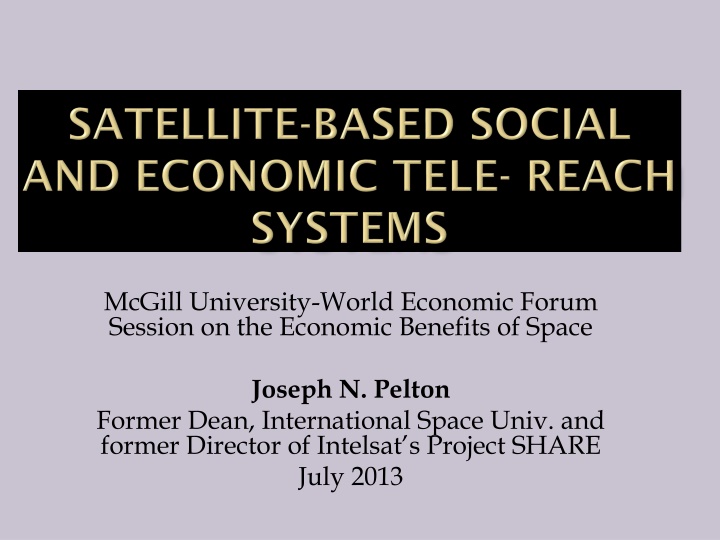

![Read⚡ebook✔[PDF] Linking the Space Shuttle and Space Stations: Early Docking Te](/thumb/21519/read-ebook-pdf-linking-the-space-shuttle-and-space-stations-early-docking-te.jpg)
![READ⚡[PDF]✔ Emerging Space Powers: The New Space Programs of Asia, the Middle Ea](/thumb/21554/read-pdf-emerging-space-powers-the-new-space-programs-of-asia-the-middle-ea.jpg)



